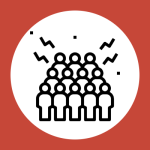Section 3 – Data Management Plans
Template for building a Data Management Plan through conversation
Isaac Pratt; Anneliese Eber; Cathy Paton; and Kaelan Caspary
Having an ongoing conversation about data
This tool refers in places to the next chapter: Data management in action which includes examples of groups storing, preserving, and sharing access to data. These can help make questions about ownership, access, and possession of the data generated for/through research clearer. This tool is meant to be used early in the research process, after the research project has been defined and initial conversations have happened, but before you have begun collecting data. Before using this tool, you should already have defined your research question and know why and how you will be collecting data.
As people who make careful decisions around research—both those of us who do it and those who take part in it—we all know that the data we create is important and needs to be managed in a careful and respectful way. This document is a guide to creating a plan for managing research data. It is not intended to guide decisions about how and why data are collected and analyzed or decisions about the goals and expectations of the research. It was created to help academic researchers, artists, community research participants, community organizers, community workers, social service workers, and others involved in research projects. It aims to be accessible as a tool for working together to create structure, agreements, and documentation.
This template scales well and can be used with organizations and projects of all sizes. While the questions won’t change, the answers and approach will be quite different. The document is meant to be comprehensive but not every question will be relevant to every project or every project member. Select which questions are relevant to your organization and research projects: not every question needs to be asked!
 Small Org: With only a few staff, you will need to clearly identify who will be responsible for data management. Small organizations may opt to use a researcher’s university storage. Make sure there are clear agreements for the org and the community to get access to research data. With small teams, you can fit everyone around the table for this conversation.
Small Org: With only a few staff, you will need to clearly identify who will be responsible for data management. Small organizations may opt to use a researcher’s university storage. Make sure there are clear agreements for the org and the community to get access to research data. With small teams, you can fit everyone around the table for this conversation.
 Large Org: Larger organizations should consider storing research data within the organization and giving access to the researcher instead. Planning for a larger organization will be more formal and may include writing policies. For this conversation, try to include everyone whose role will involve collecting, managing, or using data.
Large Org: Larger organizations should consider storing research data within the organization and giving access to the researcher instead. Planning for a larger organization will be more formal and may include writing policies. For this conversation, try to include everyone whose role will involve collecting, managing, or using data.
 No Org: If community-based research is happening with a more ad-hoc group, data will need to be stored where there is an established IT and data storage setup or work with an established organization to use their system. Try to include a few research participants or community members in this first conversation.
No Org: If community-based research is happening with a more ad-hoc group, data will need to be stored where there is an established IT and data storage setup or work with an established organization to use their system. Try to include a few research participants or community members in this first conversation.
Introduction
Throughout your partnership, you will be generating or creating some sort of “data.” As a general understanding of data—if you can use it as a building block to produce new knowledge or understanding, it could qualify as research data. We also understand that the word “data” may not resonate with you or what you intend to collect during your project. Instead of using the word “data,” for example, you might more closely identify with something like “evidence,” or “stories.” These differences in understanding are dependent on a variety of factors, such as disciplinary differences or varied expectations about what the project outputs may be. Throughout this document, we use the word “data” but please feel free to change this word to something that fits better for your partnership and your project. You can articulate which terminology best suits your project in the space below.
To refer to “data,” we will be using the word ___________________
To ensure that data is managed in a safe and ethical way, it is important to discuss and come to an agreement about:
- The collection and organization of this data
- How the data will be documented
- Where and how the data will be stored and kept safe
- How the data will be maintained and who is responsible for taking care of i
- How the data might be shared and where it will be used
The question prompts below are intended to facilitate discussion about how the data for your project will be managed. A clean version of the template is provided as a word document or excel spreadsheet that you can download and fill in. Remember, a data management plan is a living document and should be reviewed when your practices are changing or as often as needed by your organization.
At the end of this document, there are spaces for each partner to sign in agreement with this data management plan.
Data collection
Management of data for research projects is an ethical and legal responsibility. The data that you collect for this project will need to be kept safe and secure. Oftentimes, for research projects that are associated with an academic institution, you will need to gain approvals from the institutional research ethics board(s). Having upfront conversations about the safekeeping and storage of data may help you to prepare for these more formalized ethics approval processes.
What is the “data” in this project? What will we collect?
This may be survey responses, stories, interviews… (see companion document for additional examples)
Whose consent or approval do we need to collect the data for this project? Do we need ongoing consent?
See companion document for discussion of consent in data collection. In addition to participants, do you need permission from anyone else to collect data? (e.g., in workplaces or schools)
Is there anything we are reusing?
I.e. Open data from a municipality, statistical data, survey data collected by a community organization, administrative data from outreach programs, archival photos, another researcher’s field recordings/notes, samples from films, historic oral histories, maps…
Documentation
Documentation provides a record of how data are collected and worked with, as well as other organizational information. Good documentation for your data management helps ensure that everyone involved in a project can understand the data and do things consistently. In some cases, the documentation of the research process and the decisions that you make together also become data. You may see the term metadata come up in documentation guides; metadata means information about your data.
How and where will we document our process?
For example, you may choose to have a shared notebook or spreadsheet that keeps track of the project metadata.
Where will we store documentation?
Will digital documentation be stored alongside the data or separately? Is there physical documentation that needs to be kept secure?
How will we keep track of the decisions that we have made together?
This might include written minutes or recordings of partnership meetings.
Who is responsible for making sure that we document our process?
Aspects of process that you may want to consider documenting could include basic project information, research design, and methodology.
Storage and security
Where and how you store your data is an essential decision when trying to keep data safe. Projects involving university or college researchers must go through a formal ethics review which requires that you describe how you intend to store your data and keep it protected. When working with digital files (either born-digital or digitized), make sure you store them in a place that is accessible to partners but is still secure. If some of your data is physical, consider who will be storing these physical data and where, and how those materials can be backed up or digitized.
How will we ensure data is kept safe and not lost?
Our interviews, focus groups, and/or events often only happen once. How do we make sure we don’t lose what we collect?
How will we organize the data so that we can all find it and know where things are?
This includes a variety of things to organize from the very practical (i.e. what will our folder structures look like? How will we name files? What file formats do we use?) to the very conceptual (i.e. how do we make sure our organization systems are known and understood by everyone?)
How will we make sure our data is secure and accessible only to approved people?
Consider any requirements you are obligated to meet (e.g., PHIPA).
Who will have access to what we collect?
Consider if only the research team or if the larger community will have access to raw data. (see companion document for additional examples)
What will we need in terms of resources for this?
E.g., New hard drives, training for team members, access to digitization equipment.
Maintenance and care
Data Management is an ongoing process. It’s important to plan how data will be managed during and after the completion of your project and decide how long you are going to hold on to data and materials. Deciding upon who will be responsible for storing your project data and keeping it safe is a vital part of your data management plan.
When the project is over, what will we keep and how long will we keep it for?
Storage costs money and takes energy. What data is important to keep? Do we have any obligations to keep data for a certain time or to destroy certain data?
Where will everything we collect be kept when the project is done?
E.g., will the data be stored locally with the community or somewhere on institutional servers?
Who will be responsible for the care and maintenance of the project records?
Consider who will be responsible if that person or people need to step back for whatever reason.
Do we need to apply for any additional funds or allocate someone’s time towards this?
Will you need to pay for additional storage? Do existing staff have time to maintain data?
How will we ensure we are meeting our responsibilities to each other (in terms of data maintenance and care) and that everyone is on the same page?
How will we communicate to make sure everyone is on the same page or has access to the information they need?
Sharing, ownership, and reuse
To determine how the data will be managed, it is important to create a shared understanding of who owns that data, as well as how that data can be shared. Conversations about sharing may then occur around participant choices to share their story/data/artwork. You might have multiple types and sources of data for your project. Consider which of those types of data could be shared.
Do you want what is created throughout your project to contribute to the common good? If shared publicly, for example, the narratives that emerge in a workshop might have the potential to alter perceptions about a particular group of people, neighbourhood, or idea. Collaborating on what might need to be done to share this work publicly is also an important part of sharing, use, and reuse.
What outputs will we have?
Consider all types of data and research outputs associated with the project.
Who owns those outputs?
More than just from a legal perspective, who contributed to the work and whose permission do we need before we can ethically share what we’ve collected with others.
What will we share?
Will everything be shared? Will materials be anonymized or de-identified before sharing?
Do we have any obligations to share?
Funders or partners may require sharing of outputs such as data, reports, or publications. If data is kept at an institution, Community organizations and participants may require data to be shared back with them in an accessible way.
Where and how will we share data and materials?
Data can be shared via a research data repository or as a community resource.
With whom will we share it and how will we decide when to share it or not?
Data may be shared outside of the community, only within the community, only with other researchers, or publicly. Will you ask for signed agreements and require data users to follow specific conditions? Consider implementing a Data Access Committee to review and approve access.
How do we ensure that the data is available and accessible to the people it’s from or about?
Consider what people might need to access the data and think of the physical/digital logistics of data access.
What outside the data can be made entirely public for others to use?
For example, can documentation, photos, or audio clips be shared publicly?
Access this resource as a blank fillable template file

